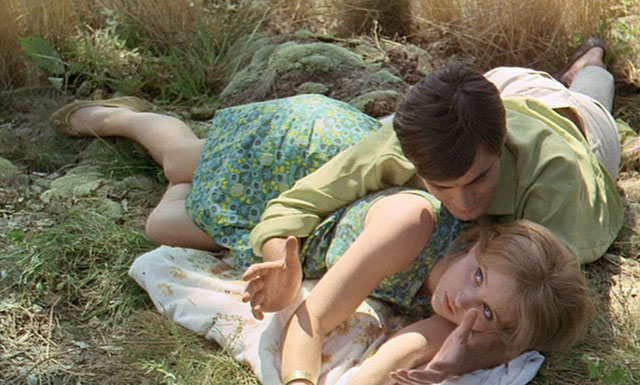
“I imagined a summer peach with its perfect colors, and inside, there is a worm. And impressionist paintings, which emanate such melancholy, though they depict scenes of everyday happiness. I listened to Mozart, I thought of death’s preponderance.”
So said director Agnès Varda when reflecting on her 1965 film Le bonheur (Happiness), a film that stands, 55 years later, as one of the French New Wave icon’s boldest and most subversive works. Made as the women’s movement of the 1960s reached a fever pitch, her first feature-length film in colour disguises a barbed feminist cautionary tale in bright summery images, examining the chilling way in which women are often mistreated and even replaced as their partners seek to fulfil both their personal impulses and the heteropatriarchal idea of the perfect nuclear family.
Le bonheur opens on a sunflower blowing gently in the breeze. Using erratic quick cuts, Varda reveals a field of yellow blooms, and four hazy figures converging on them. These figures belong to Francois (Jean-Claude Drouot) and Thérèse (Claire Drouot), a young married couple living in suburban Paris, and their toddler son and daughter. In the film’s opening moments, the four are celebrating Father’s Day on their weekly Sunday excursion to the countryside. It’s almost painfully picturesque — Mozart swells as Francois and Thérèse lounge under a tree, before joining their preternaturally obedient progeny in picking armfuls of lush wildflowers and keeping their picnic clothes pristine all the while.
Watching this idealised portrait of the family unfold in Le bonheur’s early scenes becomes meta given that the leads are played by an actual family — French TV star Jean-Claude Drouot, his wife, Claire, and their two children. The couple’s peaceful Sunday afternoon camaraderie translates seamlessly into their day-to-day lives, where Francois works as a carpenter in his uncle’s shop and Thérèse is a part-time dressmaker, left with enough time to greet her husband with a kiss and freshly prepared dinner when he returns home.

However, Francois’ idyllic day-to-day life changes when he takes a business trip to a nearby town and encounters Émilie (Marie-France Boyer), a charming postal clerk who bears an uncanny resemblance to his wife and acts just a bit bolder. The pair almost immediately strike up an easy flirtation, and after only one outing together, he declares that he loves her. Although such an exaggerated picture of domestic bliss is presented at the beginning of the film, Francois’ sudden transgression doesn’t feel so shocking. After all, Le bonheur is an early addition to what has become an entire subgenre dedicated to exposing the demons that lay behind the picture-perfect facade of an idealised suburban family, and infidelity is often one of those demons.
Varda slyly sprinkles in scenes of minor characters celebrating domestic milestones as Francois and Thérèse’s own seemingly perfect marriage is quietly upended — Thérese attends her client’s wedding ceremony while her husband sleeps with Émilie for the first time; Francois’ family gather to celebrate the birth of his new niece just before he decides to visit his lover again. What’s arguably more jarring is that Francois seemingly feels no guilt over his newfound affair. As he sees it, he has only invited more love and joy into his life by pursuing this single, more forward woman against the backdrop of his pastoral home life.
“Had I met you first, I’d live with you,” he tells Émilie matter-of-factly as they lay in bed one day. “But I met her first. I married her, and I love her. I have enough joy for both of you. Happiness works by addition.” When she presses on, asking if she and Thérèse are the same to him, Francois disagrees, but frames the two women only in relation to how they influence his own life. Émilie is more fun, and better at making love, but Thérèse is tender to him, and their children resemble her. “Thérese is like a hardy plant,” he finishes bluntly. “You’re like an animal set free. I love nature.”

After their affair has gone on for a month, Francois decides to come clean to his wife after she remarks that he seems happier than ever. Rather than outright admitting to his infidelity, he crafts yet another clichéd, flowery metaphor likening his secret ménage à trois to the order of the natural world — he, Thérèse, and their children are an apple orchard in a field, and Émilie is another apple tree, blooming and doubling their harvest. For all Francois’ pretty words, this arrangement has occurred covertly and without Thérèse’s consent as the third party. Her identity thus far has been built around ensuring her husband and their family with happiness, and if the only way to do so is to accept this violation of her trust and prescribed role in life, what is she to do? Thérèse eventually capitulates, telling her relieved husband that she loves him even more because he’s so happy. They make love and Francois falls asleep in the grass, but when he wakes, his wife has vanished.
With his two children, he winds down the same path that he and Thérèse ambled down on that utopian Father’s Day picnic not so long ago. But now, the outcome of the trip is nightmarish — he discovers Thérèse’s dead body being pulled from a nearby pond, where she has wandered off and drowned. Varda never makes it clear whether the character committed suicide or accidentally drowned during an impulsive swim. No matter how the incident happened, Francois’ idealistic metaphor of the apple trees has been turned on its head — rather than his adulterous escapades resulting in a natural over pouring of familial joy, he has inadvertently created a situation that led to his wife’s death.
Still, Le bonheur’s fatal third act twist is ultimately far less morbid than the film’s remaining 15 minutes, in which the film’s superfluous depiction of domestic harmony quickly returns. A few scenes take a gloomier cast in the immediate aftermath of Thérèse’s drowning, but even at her funeral attendees carry bouquets of bright yellow flowers, harshly harkening back to the film’s opening moments.

A few months pass, and Francois sees Émilie again in early autumn. When he asks her to love him and his children, she readily accepts and meets them in the family’s countryside spot that Sunday. Now that Émilie has taken Thérèse’s spot in the family’s weekly outing, she rapidly takes her place as its agreeable maternal figure. The young woman with her own job and apartment and freely questioned Francois’ clichéd explanations is gone, replaced with someone who simply tells him, “You are my happiness. You are my life.” In an eerie montage, we see Émilie perform the exact same domestic duties that defined Thérèse’s life — caring for the children, doing the shopping, cleaning the home, and making love to Francois.
Upon its release, Le bonheur was criticised for what some saw as a literal endorsement of the submissive women and entrenched gender roles presented on screen. And while it’s true that Thérèse and Émilie are far less emboldened than the rich female protagonists of other Varda films, like Cléo from 5 to 7, One Sings, The Other Doesn’t, and Vagabond, the director’s feminist satire isn’t any less subversive. By placing an emphasis on nature and happiness and crafting a deceptively gorgeous exterior, she lulls viewers into entertaining Francois’ sunny view of “free love.” But through callously swapping the main women at the movie’s end, Varda makes it clear that her male protagonist isn’t genuinely interested in healthy polyamory — instead, living in a patriarchal society that strictly prioritises monogamous family life, he relies on women to keep his everyday affairs in order and provide him with unlimited romantic and sexual fulfilment.
Le bonheur’s final scene is a hollow echo of the first, as the new foursome go on their Sunday outing during the last gasp of autumn. The setting, family patriarch, and strangely well-behaved kids are ostensibly the same, as another slower, slightly darker Mozart tune plays — only the agreeable blonde mother and season are different. As Francois, Émilie, and the children join hands, heading away from the camera this time, they appear like a walking cautionary tale. If the cycle of gendered power dynamics that enable the family’s morbid facade to exist continues, what other quiet domestic horrors could unravel under a bright summer sun?
by Abby Monteil
Abby Monteil (she/her) is an entertainment journalist based in Brooklyn, with writing in Insider, Film School Rejects, Film Daze, and more. You can find her on Twitter and Instagram @abbyemonteil.


Leave a comment